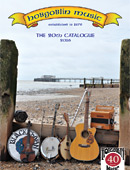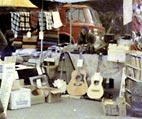

We specialise in
Accordions, Amps, Autoharps, Bagpipes, Banjos, Basses, Bodhrans, Bongos, Bouzoukis, Cajons, Citterns, Clarinets, Concertinas, Darabukas, Dulcimers, Drum Kits, Erhus, Flutes, Fiddles, Glockenspiels, Guitars, Harmonicas, Harps, Harmoniums, Indian Drums, Jaws Harps, Keyboards, Kalimbas, Lutes, Mandolins, Melodeons, Northumbrian Pipes, Ocarinas, Piccolos, Psalteries, Quenas, Recorders, Saxophones, Shawms, Strumsticks, Sitars, Tambourines, Thumb Pianos, Ukuleles, Udus, Uds, Violas, Vihuelas, Whistles, Xylophones, Xaphoons, Yang Qins, Zithers
.. and many more instruments, accessories and books for them, lessons, repairs and more.
- To give beginners a chance to take up a folk instrument, as well as to provide the best for those who already play.
- To encourage people to discover and enjoy their own musical heritage & all types of folk music now played in these islands.
- To help keep music live, by making real acoustic instruments widely available at affordable prices, and sponsoring live events.
- To encourage people to make music themselves, by taking up a musical instrument. You are never too young or too old to start!

This time appearing on BBC Radio 3
Fame can be a hard thing to live with. Some people feel constricted by it, struggle within the confines of the glass bowl, hollowed by the peering eyes of the paparazzi and the endless newspaper ...read the full story
Fame can be a hard thing to live with. Some people feel constricted by it, struggle within the confines of the glass bowl, hollowed by the peering eyes of the paparazzi and the endless newspaper ...read the full story
More News:
Visit the Hobnobbin Section for:
Selected from our Instrument FAQ
Definition: small flat backed wire-strung plucked instrument; played with a plectrum; popular from renaissance to baroque times. Modern citterns are much bigger, and more like mandolins in shape. Usually with 10 strings in 5 courses. Related to Portuguese Guitarra.
Introduction: The Cittern used by today's folk-bands has its ancestors in the renaissance Citterns and the English Guitar, but it is now more closely related to the flat-back Bouzouki - the main difference being that the Cittern has 10 strings in 5 courses, a slightly shorter neck and often a rather larger body. There doesn't seem to be a standard tuning, ADADA, ADGAD, or DGDAD, are in common use.
Read our Citterns FAQ Page or go to the Hobgoblin Instrument Info and FAQ Menu.
CITTERN
Definition: small flat backed wire-strung plucked instrument; played with a plectrum; popular from renaissance to baroque times. Modern citterns are much bigger, and more like mandolins in shape. Usually with 10 strings in 5 courses. Related to Portuguese Guitarra.
Introduction: The Cittern used by today's folk-bands has its ancestors in the renaissance Citterns and the English Guitar, but it is now more closely related to the flat-back Bouzouki - the main difference being that the Cittern has 10 strings in 5 courses, a slightly shorter neck and often a rather larger body. There doesn't seem to be a standard tuning, ADADA, ADGAD, or DGDAD, are in common use.
Read our Citterns FAQ Page or go to the Hobgoblin Instrument Info and FAQ Menu.


























